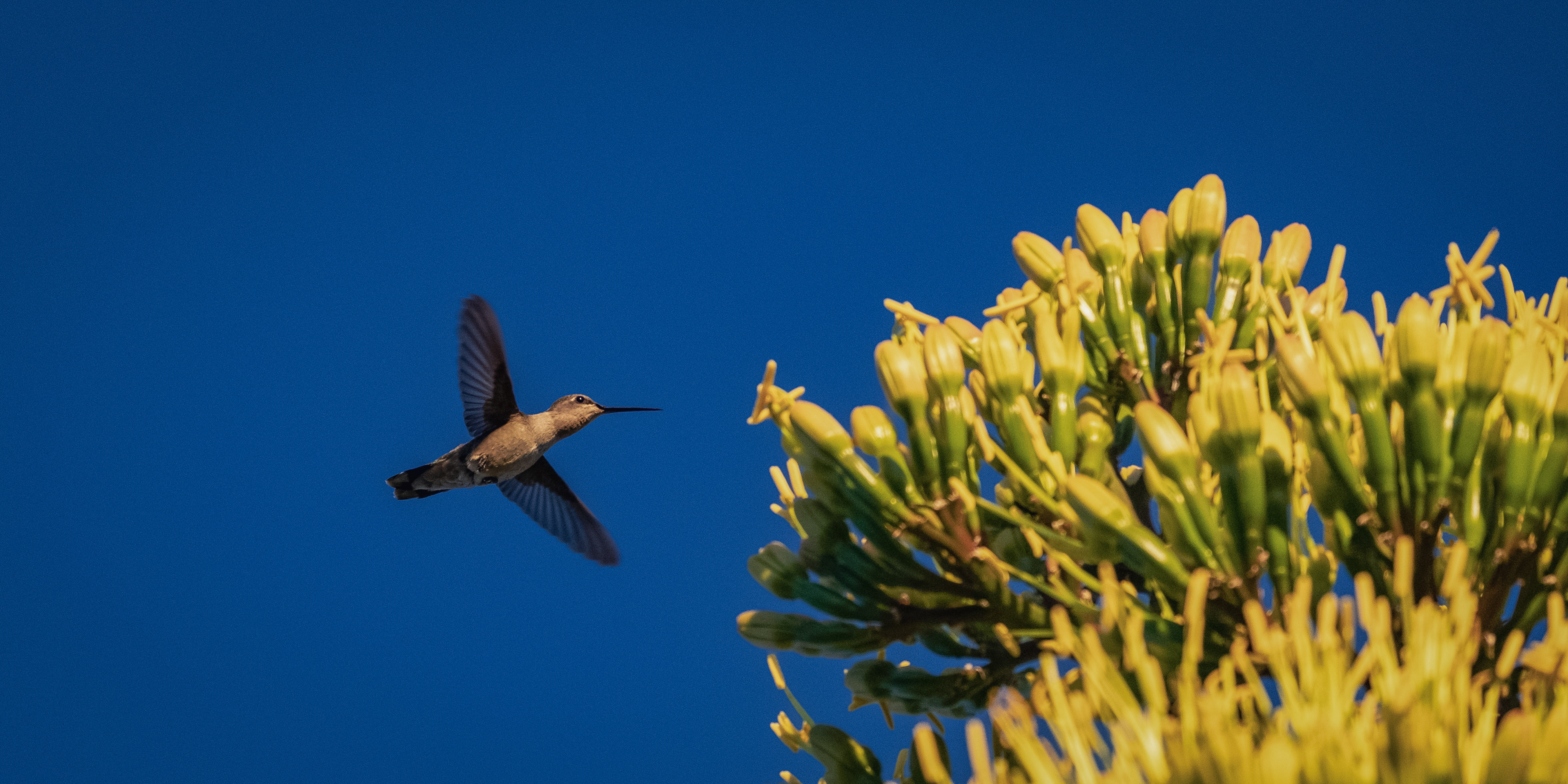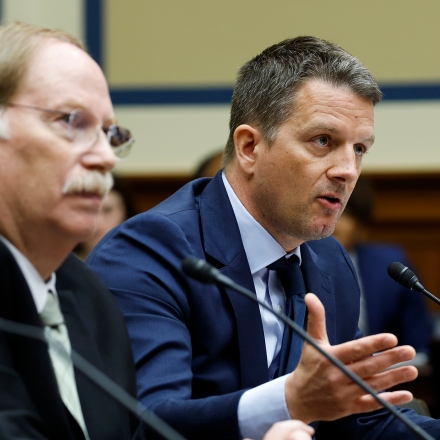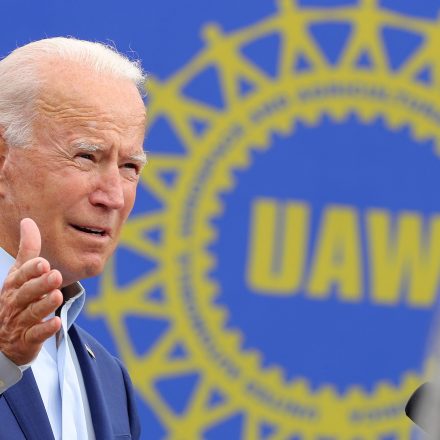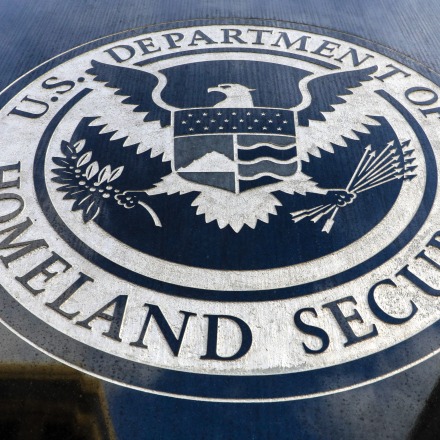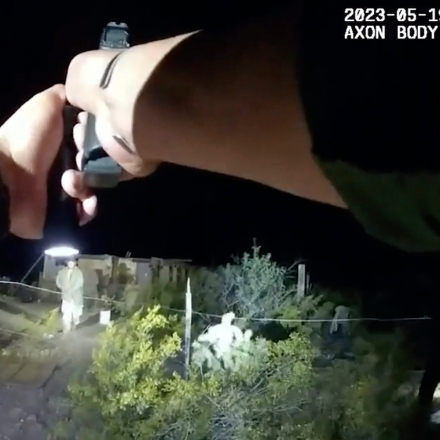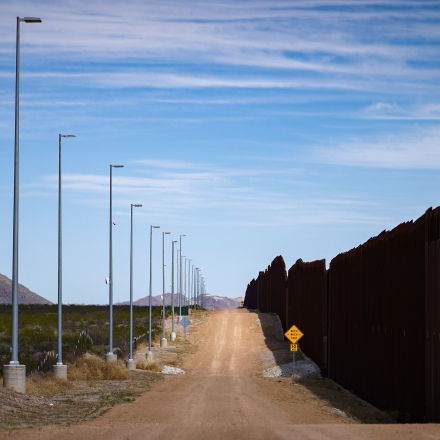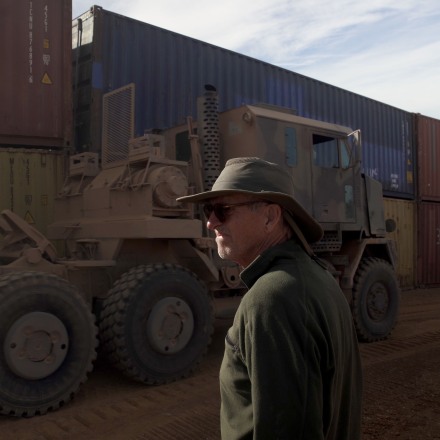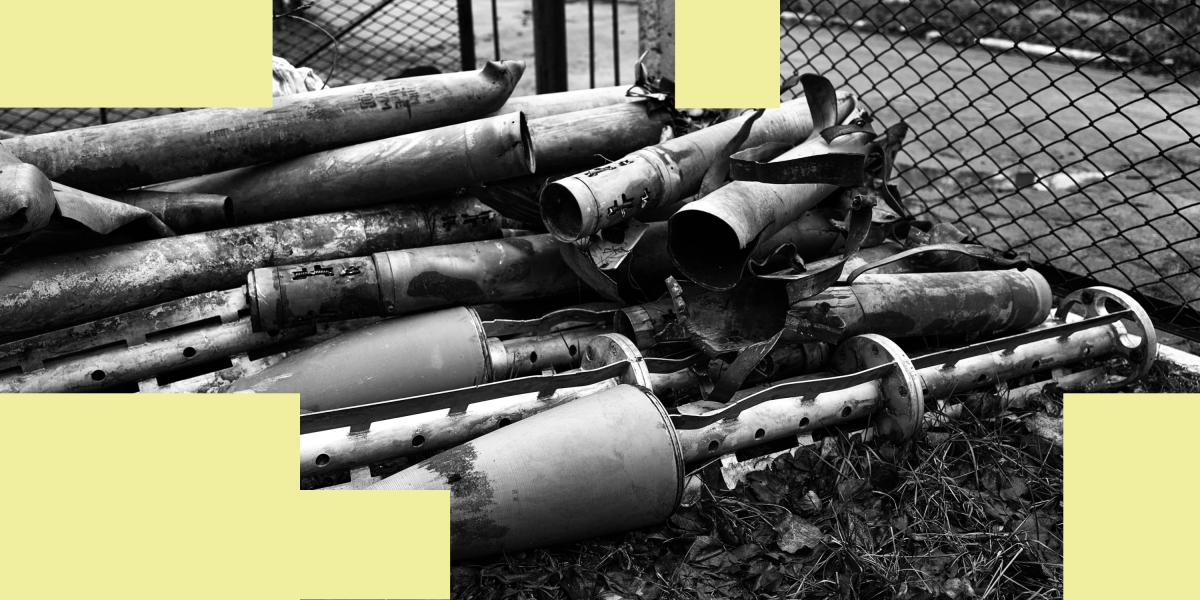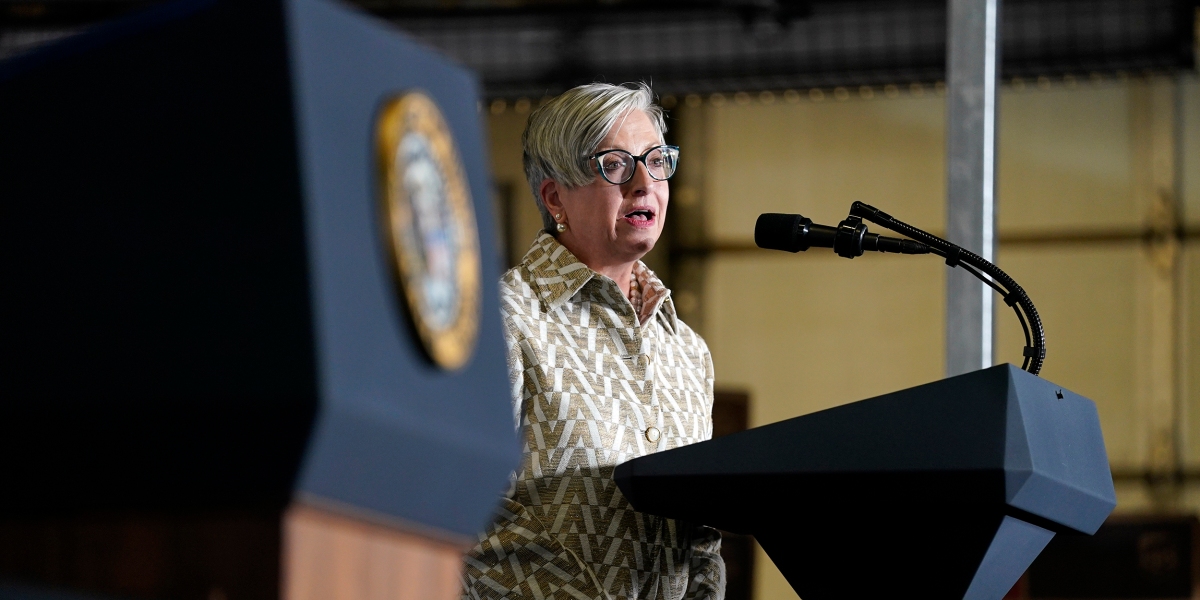Carolyn Shafer spread the maps out on her patio table. Another sun-dappled Saturday morning under her backyard trees in the picturesque border town of Patagonia, Arizona. Shafer wasn’t relaxing though. She was getting to work.
Birds chirped as the 76-year-old traced the 75,000 acres of mining claims on the edge of her community with her finger. She wore a black T-shirt emblazoned with a fearsome wolf hovering above a rugged mountain range. The wolf is the calling card of the Patagonia Area Resource Alliance, or PARA. The local group monitors industrialized mining in the Patagonia Mountains, one of the most biodiverse places on Earth. Schafer is president of the board.
“This is our new logo,” she said, picking up a pamphlet with the wolf on the front. The old mascot — a cute cartoon dog — no longer matched the moment. A vigilant pack animal sent a more appropriate message.
“We think of ourselves as local watchdogs,” Schafer told me. “We pay attention to what’s going on with the companies and the agencies, and then we bark really loudly to the big dogs, who have the staff, the knowledge, and the experience to do what is necessary.”
The big dogs, Shafer and her allies believe, are needed now more than ever. Last month, the Biden administration announced the “first-ever” inclusion of a mine in a federal program that expedites permitting for high-priority projects. In this case, it was the extraction of minerals from the Patagonia Mountains to support the president’s green energy agenda — manganese and zinc, specifically, for producing electric vehicle batteries and fortifying renewable energy installations, among other purposes. In the weeks since the announcement, the Forest Service has issued permits advancing large-scale drilling in the area.
The operation is the Hermosa project, which encroaches on the Coronado National Forest, an hour southeast of Tucson. The company is South32, an Australian spin-off from global mining giant, BHP Billiton. The program, FAST-41, was created in 2015 to streamline the federal permitting process. The Permitting Council, an agency with a nearly $100 billion portfolio in government infrastructure projects, oversees the program.
The administration’s support for the mine follows President Joe Biden’s 2022 determination invoking the Defense Production Act, which ordered an increase in domestic mining of “critical” materials sufficient to create a large-scale battery supply chain and move the nation away from fossil fuels and foreign production lines. Manganese was singled out as critical. Congressional passage of the Inflation Reduction Act also called for increased domestic mining in the name of green energy.
With an initial estimated outlay of $1.7 billion, South32 anticipates a lifespan of 22 years for Hermosa’s zinc deposit and 60 years for its manganese deposit. Full production is slated to begin in 2026 or 2027. Company executives celebrated their FAST-41 inclusion with the Permitting Council’s director in a press call last month. Hermosa project President Pat Risner drew a direct line between Washington’s goals and his company’s aims.
“These policies pave the way for a vast domestic expansion in electric vehicles, batteries, and renewable power production,” he said. “South 32’s Hermosa project is the only advanced mine development project in the U.S. currently that could produce two federally designated critical minerals as its primary products, those being manganese and zinc.”
Shafer was blindsided by the news. “That really wasn’t on our radar screen at all,” she said the first time we spoke. In the month that followed, PARA cranked up its advocacy like never before, organizing with larger NGOs and telling any reporter who would listen about the project’s extraordinary ecological stakes.

Photo: Molly Peters for The Intercept
PARA’s Lawsuit
Last Tuesday, the calls for help became a call for action. PARA, with support from the nonprofit advocates of Earthjustice and the Western Mining Action Project, filed a lawsuit in federal court against the U.S. Forest Service and the supervisor of the Coronado National Forest, where the mining activity is concentrated. Several of the region’s environmental organizations — and its most experienced litigators — joined as co-plaintiffs, including the Center for Biological Diversity, the Tucson Audubon Society, and Earthworks.
The groups alleged a series of Forest Service violations of the National Environmental Policy Act and the Endangered Species Act, resulting in the rushed release of two permits for exploratory drilling projects in the Patagonias last month. One of the projects is overseen by South32 in conjunction with the high-priority Hermosa project. According to the lawsuit, the permits impede recovery of the threatened Mexican spotted owl and the yellow-billed cuckoo, as well as disrupt federally protected migration corridors for endangered jaguars and ocelots. (The Forest Service declined to comment on the pending litigation.)
“Drilling could begin at any time.”
Hermosa project at South32 is not named in the lawsuit. In an email, Risner suggested PARA’s ecological concerns were overstated.
“With a surface footprint of just 600 acres, the Hermosa project is a fraction of the size of most mining projects and keeps sustainability at the core of our approach,” he said before the lawsuit was filed. “Hermosa has also had in place for more than a decade a robust biological monitoring program.”
PARA and its supporters called on the court to declare that the Forest Service broke the law and quash the agency’s authorizations. The moment demands urgency, they argued: “Drilling could begin at any time.”

Photo: Molly Peters for The Intercept
A Sky Island
The weekend before PARA and its allies filed their lawsuit, Shafer and her partner, Robert Gay, an architect and journalist, invited me on a bumpy drive deep into the mountains to survey the Patagonias’ rivers and canyons and offered their take on current fight and its wider implications.
The Patagonias are an iconic member of the “sky islands,” a network of mountain ranges that rise up out of the desert of southern Arizona and northern Mexico. Home to an estimated 100 endangered or threatened species, the mountains contain the largest cluster of mammal species anywhere north of Mexico, more than 500 species of birds, the highest density of breeding raptors on the planet, the most reptile and ant species in North America, and the most bee species on Earth.
The virtually unmatched biodiversity has made the town of Patagonia — with a population of around 900 residents — a world-class birding and wildlife research destination for generations. The town is also a launching point for the famed Arizona Trail, an 800-mile hike that traverses the state from north to south. More recently, it’s become home to a growing gravel bike scene, with riders pedaling through the mountains to reach the stunning San Rafael Valley, one of the last unbroken stretches of grassland ecosystems in the American Southwest.
Together with the unique abundance of flora and fauna, outdoor recreation has made Patagonia a hub in the “nature-based restorative economy” of Santa Cruz County. According to a 2021 University of Arizona study that PARA and other conservation groups in the area helped produce, the attractions generate tens of millions of dollars for local businesses and residents.
Though the battle over mining in the Patagonias goes back generations, this latest iteration is frustrating activists on the ground for reasons particular to the present moment.
Shafer and Gay are both diehard environmentalists. An “Earth Day is every day” flag hangs outside their home. They are deeply concerned about the climate crisis and would never say otherwise, but they are just as concerned about biodiversity loss and the planet’s unfolding sixth extinction. For them, a mine that would accelerate one cataclysm in the name of combatting another is unacceptable.
The minerals needed for a green energy revolution can be found elsewhere in the world, Shafer argued: “There’s no other place to go for Mexican spotted owl. Yellow-billed cuckoo. Jaguar. Ocelot.” The frustration in her voice rose as she ticked off the names.

Photo: Molly Peters for The Intercept
Wild West
In the U.S., mining is governed by a law President Ulysses Grant signed in 1872. With scant regulations, the Wild West-era statute has undergone little substantive change in the century and a half since. Technology, however, has changed. The lone Civil War veteran busting his back hoping to strike it rich in a national forest has been replaced by multibillion-dollar corporations with the most advanced extraction tools money can buy.
In the Patagonias, the main hub of activity centers around an old mine water treatment site run by the American Smelting and Refining Company, or ASARCO. In the 1960s, the endeavor collapsed in a storm of bankruptcy and environmental damages, including pollution of Patagonia’s water.
Decades later, Arizona Mining Inc., owned by billionaire mining tycoon Richard Warke, purchased the land. South32 bought out Arizona Mining in 2018, in a $2 billion sale that marked one of the biggest mining deals of the year.
The area surrounding the old ASARCO site is largely national forest land, which South32 is actively exploring, as well as ranches and other parcels of private property. The privately held land is shrinking though, with South32 buying up properties one by one in recent years.
“It’s very, very active out here right now,” Shafer said. “These mountains, unfortunately, are chalked full of valuable minerals.”
For Shafer, the heart of the matter is water. Patagonia relies on the mountains entirely for its water, but the range’s hydrological significance doesn’t stop there. The mountains are the headwater of Sonoita Creek, which flows into the Santa Cruz River that provides water for more than a million people.
“The community’s concern is: What is this going to do to that ecosystem?”
When ASARCO was running its mine in the 1960s, the company’s chief problem was water; it would fill the mine’s shaft and the company lacked the technology to keep it out. Facing the same challenge today, South32 has received permission from the Arizona Department of Environmental Quality to run up to 4,500 gallons of water per minute through one of its two water treatment plants, then dump that water into Harshaw Creek, a tributary to Sonoita Creek. At max capacity, Shafer noted, that would mean more than 6.4 million gallons of water flowing into the Harshaw on a potentially daily basis.
“We don’t know how much water they’re taking out and using on site, but that’s how much they are permitted to discharge into the Harshaw Creek,” Shafer said. “The community’s concern is: What is this going to do to that ecosystem?”

Photo: Molly Peters for The Intercept
“Desiccate and Saturate”
A small stretch of the Harshaw has perennial water. Monsoon season aside, the water tends to lap around a person’s ankles. The rest of the creek is typically dry. What 6.6 million gallons of water a day would do — and more when the heavy rains of late summer hit — is difficult to fathom.
To put the town at ease, South32 released a video last year. The minerals the U.S. government seeks lie below the water table under the Patagonia Mountains, the company explained. South32 would drop the table by pumping water out. The water would then pass through a treatment plant before being dumped into the Harshaw. This would create “a cone of depression” around the well site, allowing safe underground work.
“Most of the discharged water will soak back into the ground. Some will evaporate or be used by vegetation, but most will recharge the aquifer without ever reaching the town of Patagonia,” the company said. Even in the event of a 100-year, 24-hour flood, the increase would not have an “adverse effect” on the hamlet, South 32 said, nor did the company “expect that wildlife would be negatively affected.”
PARA consulted with hydrological experts and responded with a video of its own. Noting that South32 planned to pump “the equivalent of 10 Olympic-size swimming pools per day” into the Harshaw every day for up five years, the experts predicted the creek would quickly go from almost entirely dry to constantly flowing, carrying any undetected contaminants from the mine wherever it ran and heightening flood risks during monsoon season.
As we prepared to head out for our drive into the mountains, Gay pulled out a poster he made, detailing the expanse of water South32 expects the town of Patagonia to receive in the event of the 100-year flood — and how it would cover the town’s properties. “When you look at that closely,” he said, “it’s 70 percent of the lots now.”
In Patagonia, the problem would be too much water. In the mountains, it would be the opposite. “My fear is it’s going to dewater the mountain,” Shafer said. “If it dewaters the mountain, it kills the plant life. If it kills the plant life, there’s no place for this incredible biological diversity to survive. That’s my bottom line, but that’s not speaking as the organization. That’s speaking as Grandmother Carolyn.”
“It’s feast or famine,” Gay added. “I call it desiccate and saturate.”

Photo: Molly Peters for The Intercept
Hoping for a Miracle
Patagonia’s paved roads disappeared in the rear-view mirror. Gay’s beat-up 4Runner crept slowly over the rough terrain. Approaching the old ASARCO site from the north, we passed abandoned mining tunnels from decades before, ranches that had been sold to the mining company, and others that soon might be.
“It is a patchwork of extreme complexity,” Gay said, leaning forward on the wheel. “Just a snarl, between the bumpiness of the land and the irregularity of the property lines.”
At a town council meeting last month, South32 presented its plan for managing the convoys of trucks that would run these roads, hauling minerals for green energy out of the mountains. In the early stages, it would be 62 heavy trucks, 26 buses, and 139 passenger vehicles daily. The flow would increase as the project became fully operational, at which point more than 200 heavy-duty trucks — in addition to the buses and passenger vehicles — would come through.
Given the landscape, traffic at that scale would require significant road work and with it, the obliteration of the mountains’ otherwise serene quiet. Like the water in Harshaw Creek, the change was difficult to imagine.
“Patagonia in 10 or 15 years won’t be recognizable anymore,” Patagonia Vice Mayor Michael Stabile said in an interview in the Patagonia Regional Times. Stabile was a founding member of PARA, though he no longer works with the organization. “They’re going to flood us with water,” he said. “And they’re going to flood us with trucks.”
“Patagonia in 10 or 15 years won’t be recognizable anymore.”
Days before we met up, Shafer had a similar moment of unsettling clarity. “I just realized I have shifted into grief about what is happening here,” she said. “Because of the realization of how special this is to me and that I will not be able to come out here for at least seven years, and when I do get to return, what will it be like?”
South32’s assurances about safeguarding the ecological systems were cold comfort for Shafer. “There’s nothing legally we can do to stop it. What we can legally do is mitigate the potential damage. That’s what we’re working very hard to do,” she said. “But unless something under the definition of miracle happens, there will be destruction by industrialized mining in these mountains.”
“The disaster of that,” Shafer said, “is that this is one of the regions of the world most in need of protection for species survival.”

A flag outside Carolyn Shafer’s home declares “Earth Day is every day.”
Photo: Molly Peters for The Intercept
The Cathedral
There was little to see at the old ASARCO site. A locked gate. A handful of “no trespassing” signs. We turned around and headed west into Humboldt Canyon, where work is currently overseen by Barksdale Capital Corp., a Canadian company specializing in mineral exploration — the kind that precedes a company like South32.
“I am in a stronger relationship with the natural world in this canyon than I am in any other canyon,” Shafer said, as we passed under a majestic spire of twisted rock. “This is a spiritual experience for me — full of experiences of dear friends of mine.”
Years back, Shafer officiated her friends’ wedding in the canyon. The couple was among PARA’s original founders. The groom was Glen Goodwin, an old-school Arizona cowboy who, in 2014, detected extensive water contamination stemming from the Patagonias’ old mine sites — including sites that are revving back up again today. Goodwin died last year. His ashes were spread in Humboldt Canyon.
The road twisted deeper into the mountains until coming to a stop in a clearing. Shafer got out and leaned against a tall pine tree, listening to the birds. “For me,” she said, “this meets the classic definition of a cathedral.”
On our way off the mountain, we stopped to watch mule deer grazing in a field. We dropped Gay off in town before leaving for the tour’s final destination: the perennially flowing stretch of Harshaw Creek.
Willow trees lined the way, along with massive Arizona sycamores. We walked down to a particularly beautiful bend in the creek. Shafer mentioned a paper she recently heard about discussing the mental health benefits of birdsongs.
“When you live with something all the time, you don’t think much about it,” she said. “But I have birdsong all day long, and it is something I do appreciate.”
Shafer is the last of PARA’s original core still living and working in Patagonia. “Two are now dead, two have moved out of country,” she said. She knows that stopping the mine is next to impossible, but then, the same could be said of her.
Shafer’s mission now is making the cost of doing business in the Patagonias match the value of the place. “I’m sorry if you’re not going to get a 25 percent profit margin,” she said. “If you have to live with 5 percent to honor what is here and you don’t like that, then go away.”
She leaned forward, smiling, and added in a whisper, “It wouldn’t hurt me if you left.”
